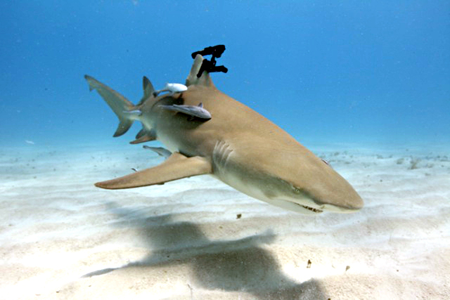Marine Biologist Attaches LASER To A Shark’s Head. The End Times Are Upon Us.
Hey, let’s give robots intelligence. Hey, let’s slap a laser onto the dome of a shark. Day by day, we’re inviting the apocalypse.
I Heart Chaos:
While this laser beam isn’t on the shark’s fricking head, it is firmly attached to its dorsal fin with a temporary clip. Why did someone go and clip a powerful green laser to a shark? Because they can. Duh.
Marine biologist-cum-TV personality Luke Tipple attached a 50-milliwatt green laser to a lemon shark off the coast of the Bahamas in late April. The escapade was sponsored by Wicked Lasers, a consumer-focused laser manufacturer based in Hong Kong that produces some of the most brilliant – and potentially dangerous – handheld lasers in the world.
“This was definitely a world first,” Tipple told Wired. “Initially, I told them no. I thought it was a frivolous stunt. But then I considered that it would give us an opportunity to test our clips and attachments, and whatever is attached to that clip, I really don’t care. It was a low-powered laser that couldn’t be dangerous to anyone, and there’s actually useful applications in having a laser attached to the animal.”
Tipple said the experiment was instructive in a number of ways. For starters, he was able to further test his clamping apparatus, which is typically used for traditional data-aquisition equipment.
He also wanted to verify anecdotal evidence that sharks avoid laser energy of specific spectrums and wavelengths. Curiously, at least with the Wicked Lasers model, he found the opposite to be true: “Although further testing is necessary, time and time again, sharks were actually attracted to the laser beam,” he said.
Finally, he said the experiment was helpful in measuring a shark’s velocity and trajectory in real time. “We were able to see how their body positioning relates to a target,” he said. “You can get a very clear description, via the laser, of what the shark’s body is doing.”
Other experts find the Wicked Lasers stunt of dubious value, and we’ll get to those criticisms soon. But for now, let’s describe exactly what went down in the Caribbean on Apr. 24.
Wicked Lasers supplied Tipple with the lowest-powered version of its S3 Krypton green laser. Where a simple laser pointer might generate a beam measuring about 2mW in power, the shark-deployed model, operating on its low-power setting, emitted a beam in the neighborhood of 50mW. This isn’t a beam that can be safely shined in anyone’s eye, but it’s nowhere near as dangerous as the 1-watt Krypton model Gadget Lab tested in October 2011.
Tipple says the laser was attached to a lemon shark’s dorsal fin via a “non-invasive clamp” applied by a diver to ensure correct positioning. Tipple says he chose a lemon shark – Negaprion brevirostris – for its “predictable and relatively docile swimming behavior during the day, ease of access in shallow water, and size of the dorsal fin.”
In other words, the shark was easily corralled and size-appropriate, and probably wouldn’t stray very far during the stunt. And, indeed, Tipple’s team was able to retrieve the host shark by the end of the experiment, and remove the clamp.
“The clamp has specially designed gel pads on the inside of its jaws that create a tactile surface interaction with the dermal denticles of the sharks skin, so basically it doesn’t move,” Tipple says. “Zinc elements of the spring device within the clamp are designed to corrode and would lessen the grip of the clamp within a week. In around a month, the spring would be rendered useless, causing the clamp to simply fall off.”
So how did the shark respond to its evil laserfication?
“The shark didn’t really like it when I initially deployed the clamp,” says Tipple, “but after a few seconds it returned to normal behavior. The clamp itself isn’t strong enough to cause any pain, and the dorsal fin is actually not very sensitive due to it being composed primarily of cartilage.
TL;DR? We’re inviting the end times. Day by day.




